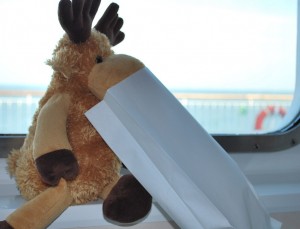When I was a kid, a friend of mine had a t-shirt that read, “Beer: Breakfast of Champions.” Now, thirty years later, I took a Tallink cruise and realized the words on the t-shirt weren’t a joke. In fact, my wife Liina suggested they could even be Tallink’s slogan.
We were aboard the “Romantika” sailing for Sweden, home of what are known in Canada to be clean, pristine, well-mannered Scandinavians. I expected a boat full of smiling blondes in cable-knit sweaters, hands still creamy from churning butter by hand and yodeling tunes from “The Sound of Music” against a sunny, mountainous backdrop. But instead, I got vomit.
If a reader believes I may be inclined toward poetic license and manufacture such details, he may verify my story by checking the Tallink terminal cleaning log. “March 24th, 17:10 hours: One large vomit pie directly inside the terminal’s main entrance.” If Tallink doesn’t keep such logs, I may be persuaded to share my high-resolution photograph.
My party advanced to the “Romantika” and we sailed without further incident. I soon convinced myself that if I’d had my “Miami CSI” junior crime lab kit with me, I’d have been able to conclude that the vomit inside the terminal was not from a passenger aboard my ship. Chemical analysis would prove it to be vomit of Finnish origin.
The Swedish passengers, however, failed to meet my expectations. I saw no cable knit and very few smiling blondes. Youngsters wore jeans slung low like wannabe gangsters from an American MTV video, and their shaggy-dog haircuts reminded that Sweden is a country where the 1970s never died.
But children and adults alike were painstakingly courteous, and the usual elbowing for a place in the buffet line was replaced by “after yous” and offers to cut an extra piece of bread for the next passenger. We all simply lined up and ate. It was all too civilized.
Fortunately, I was seated at a table with a former officer of the cargo vessel “Sigulda” that regaled us with tales of sailing under the Soviet flag to Beirut in 1979. The city burned, half-sunken ships smoked in the harbor, and yet the good ship “Sigulda” sailed on through dangerous waters to deliver her cargo to the citizens of Beirut.
“What were you carrying?” asked Liina.
“Laundry detergent,” replied the officer.
“Then you’re a hero.”
“Indeed,” laughed the officer. “Nothing like detergent to clean up after a war.”
The officer told more stories. He told us how the Estonian ship “Georg Ot” carried Gorbachev to the Iceland Summit. How Gorbachev traveled with his personal chef, wine collection, and seven kinds of imported cheese for breakfast. He talked about the good old days when working on a cruise vessel was a rare privilege and the crew stood shipshape in starched shirts and creased pants.
But aside from the excitement the officer provided, there wasn’t much action to be found on the boat. In the absence of cruising Finns to wrestle with — or Tallink management to fist fight — we had to manufacture our own fun.
Liina and a friend went to the ship’s makeup store where they amused themselves by applying too much rouge and coloring their eyelids bright blue. Resembling circus clowns, they approached Estonian shopgirls and asked in Russian, “Krassivõije, da?” The shopgirls, not too convincingly, agreed.
A Swedish passenger, seeing the girls in an early stage of makeup application, took Liina for the ship’s makeup consultant, and asked her for advice. “Bright and shiny always beautiful,” replied Liina in heavy Russian-accented English. “Pretty woman reflect light like mirror.”
The officer and I remained in the restaurant, autographing the wine bottles they leave on tables with our best rendition of Toomas Hendrik Ilves. We tried out the only Swedish we knew on the waiter: “Hüür monga elefanten här dü homma?”
If I understood correctly, the waiter responded that he had no elephants at home and that Ilves’ signature on a wine bottle did not, in fact, make it more valuable.
Stockholm itself was uneventful. Everything was clean, the people polite, and city completely devoid of gunfights and car chases. There was good shopping, though. Except for public transport, everything was cheaper than in Tallinn. Flowers, clothing, even lunch in a tourist trap was cheaper. There were lots of savings, but not much excitement. We were glad to return to the ship.
The voyage home was in closer keeping with what I’ve come to expect from a Tallink cruise. A posse of Swedes celebrated their youth with mild rioting, tearing up and down through the ship’s passageways all night long. No one slept, but then you’re not supposed to on what is known in English as a “booze cruise.”
The next morning, the ship resembled Beirut as the officer had described it. Vomit and spilled drinks covered the floors of the passageways, food littered the carpet, and one area was flooded, thanks to a passenger who decided the ceiling fire extinguisher was optimally suited to hang clothing.
By the time we arrived in Tallinn, the crew had miraculously disinfected the hallways, repaired the flood damage, and made the ship vomit-free. The “Romantika” was about as romantic as it could ever get.
It’s true what some Estonian politicians have said that Estonia is becoming just another boring northern European country. The Tallink cruises just ain’t what they used to be. Of course it could be, too, that I’m just getting older.
This article was written by the author of the book Inherit the Family: Marrying into Eastern Europe stories by Vello Vikerkaar.
Disclaimer:
Views expressed in the opinion section are never those of the Baltic Reports company or the website’s editorial team as a whole, but merely those of the individual writer.













